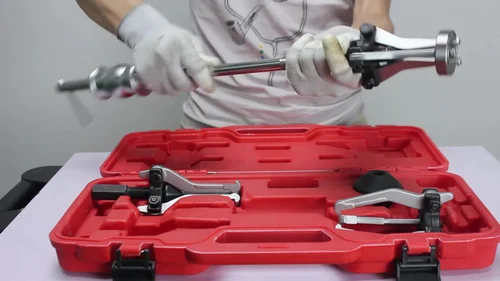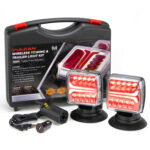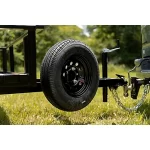What Is a Slide Hammer Puller?
A slide hammer puller is a specialized tool used for removing objects that are tightly fitted or stuck in place. It consists of three main components: a weight (hammer), a shaft, and a set of jaws or pulling attachments. The basic mechanism involves using the weight’s inertia to apply a sudden, forceful pull on the object being removed.
The weight, typically made of heavy metal like steel, slides along the shaft. When the weight is slid back and then allowed to slide forward, it builds up momentum, creating a powerful pulling force. The jaws or pulling attachments are designed to securely grip the object being removed, transferring the force from the sliding weight.
Slide hammer pullers are effective for dislodging bearings, bushings, gears, and other tightly fitted components from shafts, housings, or bores. The sudden impact created by the sliding weight helps overcome the friction or corrosion that may be holding the object in place, making it easier to remove without damaging the surrounding components.
Table of Contents
Applications and Uses
Slide hammer pullers are versatile tools with a wide range of applications in various industries. They are commonly used in automotive repairs, machinery maintenance, and construction projects.
Automotive Repairs: Slide hammer pullers are essential tools in auto repair shops and garages. They are used for removing stuck or seized components, such as bearings, bushings, and pulleys from shafts or housings. This tool is particularly useful for removing parts that are difficult to access or require significant force to dislodge.
Machinery Maintenance: In industrial settings, slide hammer pullers play a crucial role in maintaining and repairing machinery. They are used to remove bearings, gears, and other components from shafts, housings, or assemblies. This tool is invaluable for maintenance technicians working on heavy machinery, such as conveyor systems, industrial pumps, and manufacturing equipment.
Construction Projects: In the construction industry, slide hammer pullers are used for a variety of tasks, including removing stuck or damaged components from structures or equipment. They can be used to dislodge anchors, bolts, or other fasteners that have become seized or corroded over time. This tool is particularly useful in demolition or renovation projects, where components need to be removed without causing excessive damage to surrounding structures.
Slide hammer pullers are versatile tools that can be used in various applications where components need to be extracted or dislodged with controlled force. Their ability to apply concentrated impact force makes them indispensable in situations where traditional methods may not be effective or practical.
Types of Slide Hammer Pullers
Slide hammer pullers are available in various types to accommodate different applications and job requirements. The primary categories are internal and external slide hammer pullers, which are designed for removing internal or external components, respectively.
Internal Slide Hammer Pullers
Internal slide hammer pullers are used for extracting components like bearings, gears, and bushings from shafts or housings. These pullers feature a long, slender shaft that can be inserted into the component’s inner diameter. The pulling force is applied from the inside, allowing for controlled and precise removal.
External Slide Hammer Pullers
External slide hammer pullers are designed for removing components mounted on shafts or housings from the outside. They consist of a sturdy frame or fork that hooks onto the outer diameter of the component being pulled. The sliding hammer weight applies the necessary force to dislodge the component from its mounted position.
Slide hammer pullers also vary in terms of weight and shaft length to accommodate different sizes and weights of components:
Weight Variations
Lighter slide hammer pullers, typically ranging from 2 to 10 pounds, are suitable for smaller components or applications where excessive force is not required. Heavier pullers, ranging from 10 to 30 pounds or more, are designed for more stubborn or larger components that require greater pulling force.
Shaft Lengths
The shaft length of a slide hammer puller determines the depth or reach it can achieve. Shorter shafts are suitable for components closer to the surface or in tight spaces, while longer shafts allow access to components deeper within housings or assemblies.
By offering a variety of types, weights, and shaft lengths, slide hammer pullers can effectively handle a wide range of pulling and extraction tasks across various industries and applications.
How to Use a Slide Hammer Puller
Using a slide hammer puller is a straightforward process, but it’s essential to follow the proper steps and safety precautions to ensure effective and safe operation. Here’s a step-by-step guide on how to use a slide hammer puller:
- Prepare the Work Area: Clear the area around the object you want to remove or install. Ensure that you have enough space to operate the slide hammer puller safely and without obstructions.
- Select the Appropriate Puller: Choose a slide hammer puller that is compatible with the size and type of the object you’re working with. Using the wrong size or type of puller can damage the object or the puller itself.
- Attach the Puller: Properly attach the slide hammer puller to the object you want to remove or install. Follow the manufacturer’s instructions for attaching the puller to the object. Ensure that the puller is securely fastened and won’t slip during operation.
- Adjust the Puller: If necessary, adjust the puller to ensure a proper fit and alignment with the object. Some pullers have adjustable components that allow you to customize the fit.
- Safety Precautions: Before operating the slide hammer puller, take the necessary safety precautions. Wear appropriate personal protective equipment (PPE), such as safety glasses, gloves, and sturdy footwear. Clear the area of any bystanders or objects that could be struck by the sliding weight.
- Operate the Puller: Grasp the sliding weight firmly and pull it back to the end of the puller’s stroke. Release the weight, allowing it to slide forward and impact the puller’s head. Repeat this process, applying consistent force until the object is removed or installed.
- Apply Lubricant (if needed): If the object is stuck or difficult to remove, you may need to apply a lubricant or penetrating oil to help loosen it. Follow the manufacturer’s recommendations for appropriate lubricants.
- Maintain Control: Keep a firm grip on the puller and maintain control throughout the process. Avoid jerking or sudden movements that could cause the puller to slip or damage the object.
- Inspect and Adjust: Periodically inspect the puller’s attachment to the object and make any necessary adjustments to ensure a secure fit. If the puller becomes misaligned or loose, stop and re-attach it properly before continuing.
- Disengage and Clean Up: Once the object is successfully removed or installed, disengage the puller according to the manufacturer’s instructions. Clean and store the puller properly for future use.
Remember, safety should always be the top priority when using a slide hammer puller. Follow all manufacturer’s instructions and exercise caution throughout the process to avoid accidents or injuries.
Choosing the Right Slide Hammer Puller
When selecting a slide hammer puller, it’s essential to consider various factors to ensure you get the right tool for your specific application. Here are some key considerations:
Weight and Size: Slide hammer pullers come in different weights and sizes. Heavier pullers are typically used for more demanding tasks, such as removing large bearings or bushings. Lighter pullers are suitable for smaller jobs or when working in tight spaces. Consider the weight you can comfortably handle and the size of the components you’ll be removing.
Stroke Length: The stroke length refers to the distance the hammer can travel along the shaft. A longer stroke length provides more force, making it easier to remove stubborn components. However, longer stroke lengths may not be suitable for confined spaces. Choose a stroke length that matches your application and workspace.
Shaft Diameter and Length: The shaft diameter and length determine the puller’s reach and compatibility with different components. Larger diameters are typically used for heavy-duty applications, while smaller diameters are better suited for lighter tasks or tight spaces. Ensure the shaft length is appropriate for the components you’ll be working with.
Pulling Capacity: Slide hammer pullers are rated for their maximum pulling capacity, which is the force they can exert. Make sure to select a puller with a pulling capacity that exceeds the expected resistance of the components you’ll be removing. This will ensure the puller can handle the job effectively.
Accessories and Attachments: Many slide hammer pullers come with various attachments and accessories, such as different jaw sizes, adapters, and extensions. Consider the types of components you’ll be working with and choose a puller with the appropriate accessories to ensure compatibility and versatility.
Material and Construction: Slide hammer pullers are available in different materials, such as steel, aluminum, or composite materials. Steel pullers are generally more durable and suitable for heavy-duty applications, while aluminum or composite pullers are lighter and may be preferred for portability or working in tight spaces.
By considering these factors, you can ensure that you choose a slide hammer puller that is well-suited for your specific application, providing the necessary force, reach, and versatility to get the job done efficiently and safely.
Maintenance and Care
Proper maintenance and care are crucial to ensure the longevity and safe operation of your slide hammer puller. Here are some essential steps to follow:
Cleaning: After each use, thoroughly clean the slide hammer puller to remove any dirt, grease, or debris that may have accumulated. Use a degreaser or solvent to remove stubborn grime, and then wipe down the tool with a clean cloth. Ensure that all moving parts are free from obstructions.
Storage: Store your slide hammer puller in a dry, clean environment, away from excessive moisture or humidity. If possible, keep it in a toolbox or case to protect it from dust and accidental damage. Avoid storing the tool in direct sunlight or extreme temperatures, as this can cause the materials to degrade over time.
Inspection: Before each use, inspect your slide hammer puller for any signs of wear or damage. Check for cracks, dents, or excessive rust on the metal components. Ensure that the weight slides smoothly along the shaft and that the handle is securely attached. If you notice any significant damage or wear, it’s best to replace the tool or have it professionally repaired.
By following these simple maintenance and care steps, you can extend the lifespan of your slide hammer puller and ensure that it operates safely and effectively for years to come.
Safety Considerations
Safety should be the top priority when using a slide hammer puller. These tools generate significant force, and improper use can lead to injuries or damage. Here are some essential safety considerations:
Proper Techniques
- Always follow the manufacturer’s instructions for safe operation.
- Ensure the slide hammer puller is securely attached to the component you want to remove before applying force.
- Maintain a firm grip on the tool and keep your hands away from the impact area.
- Apply force in a controlled manner, avoiding sudden jerks or excessive force.
Protective Equipment
- Wear safety glasses or goggles to protect your eyes from flying debris or metal shards.
- Use work gloves to improve grip and protect your hands from pinch points or sharp edges.
- Wear steel-toed boots or shoes to prevent foot injuries in case the tool or components fall.
- Consider wearing a hard hat if working in an environment with overhead hazards.
Workspace Setup
- Clear the work area of any clutter or obstructions that could interfere with the tool’s operation or cause tripping hazards.
- Ensure adequate lighting to maintain visibility and avoid shadows that could obscure potential hazards.
- If working on a vehicle, follow proper jacking and support procedures to prevent the vehicle from falling or shifting.
- Use sturdy work surfaces or benches to provide a stable platform for the job.
By following these safety considerations, you can minimize the risk of accidents and ensure a safe and effective use of slide hammer pullers.
Advantages and Disadvantages
Advantages:
- Slide hammer pullers are relatively inexpensive and cost-effective tools compared to specialized hydraulic pullers or heavy-duty equipment.
- They are portable and can be easily carried to the job site, making them convenient for various applications.
- Slide hammer pullers are versatile tools that can be used for removing bearings, bushings, gears, and other stuck or frozen components from shafts or housings.
- They provide a significant amount of pulling force through the sliding weight and hammer action, allowing for efficient removal of stubborn parts.
- Slide hammer pullers are relatively simple to operate and require minimal training, making them accessible to both professionals and DIY enthusiasts.
- They are available in different sizes and weight capacities, allowing users to choose the appropriate tool for their specific application.
Disadvantages:
- Slide hammer pullers may not be suitable for extremely large or heavy components, as they have limited pulling force compared to hydraulic or mechanical pullers.
- Repeated use of slide hammer pullers can be physically demanding, as the user needs to apply force repeatedly to generate the necessary pulling action.
- In tight or confined spaces, the sliding weight and hammer action of the slide hammer puller may be difficult to maneuver.
- Improper use or excessive force can potentially damage the component being pulled or the surrounding area.
- Slide hammer pullers may not be effective for components that are severely corroded or seized, requiring more specialized tools or techniques.
- The pulling action of slide hammer pullers can be less controlled compared to other pulling methods, increasing the risk of sudden releases or component damage.
Slide Hammer Puller Accessories
Slide hammer pullers are versatile tools, but their effectiveness can be further enhanced with the use of accessories. These additional components, attachments, and kits expand the capabilities of slide hammer pullers, allowing them to tackle a wider range of applications and ensure optimal performance.
One essential accessory is a set of adapters or pulling attachments. These attachments come in various shapes and sizes, enabling the slide hammer puller to grip and remove different types of bearings, bushings, or other components. Some common attachments include internal and external grip jaws, hook adapters, and specialized forks or claws designed for specific applications.
Another useful accessory is a bearing splitter or separator kit. These kits typically include wedges, spreaders, and other tools that facilitate the separation of bearings or bushings from their housings or shafts. They can be used in conjunction with the slide hammer puller to apply controlled force and safely remove stuck or seized components.
For heavy-duty applications or when working with larger components, slide hammer puller extension rods can be invaluable. These rods increase the overall length of the slide hammer, providing greater leverage and force, making it easier to dislodge stubborn or tightly fitted parts.
In some cases, slide hammer pullers may require additional support or stabilization to prevent damage to the surrounding components or ensure proper alignment. Support fixtures, such as bearing pullers or support blocks, can be used to provide a stable base and distribute the pulling force evenly.
Finally, many manufacturers offer complete slide hammer puller kits that include the puller itself, along with a variety of adapters, attachments, and accessories. These kits are convenient and cost-effective solutions for professionals or enthusiasts who need a comprehensive set of tools to handle various pulling and extraction tasks.
By investing in the right accessories, users can maximize the versatility and effectiveness of their slide hammer pullers, ensuring they have the right tools for any job that requires the removal of stuck or seized components.
Tips and Tricks
Expert Advice:
- Apply a small amount of lubricant or penetrating oil to the shaft and components before using the slide hammer puller. This will help reduce friction and make the pulling process smoother.
- For stubborn or rusted components, apply heat to the area before attempting to pull. The heat will help expand the metal and break the bond, making it easier to remove.
- If the slide hammer puller is not making progress, try tapping the end of the tool with a mallet or hammer. This can help dislodge the component and provide additional force.
- When pulling bearings or bushings, use a bearing splitter or puller attachment to evenly distribute the force and prevent damage to the component.
Troubleshooting Common Issues:
- If the slide hammer puller is slipping or not gripping properly, check the condition of the jaws or claws. Replace them if they are worn or damaged.
- If the slide hammer puller is not generating enough force, consider using a larger or heavier model. Some components may require more pulling power.
- If the component being pulled is not moving, check for obstructions or interference. Ensure that the area around the component is clear and that the puller is properly aligned.
- If the slide hammer puller is bending or deforming, stop using it immediately. This indicates that the tool is being overloaded or misused, and continuing could lead to damage or injury.
By following these tips and tricks, you can maximize the effectiveness of your slide hammer puller and ensure a smooth and successful pulling operation.



